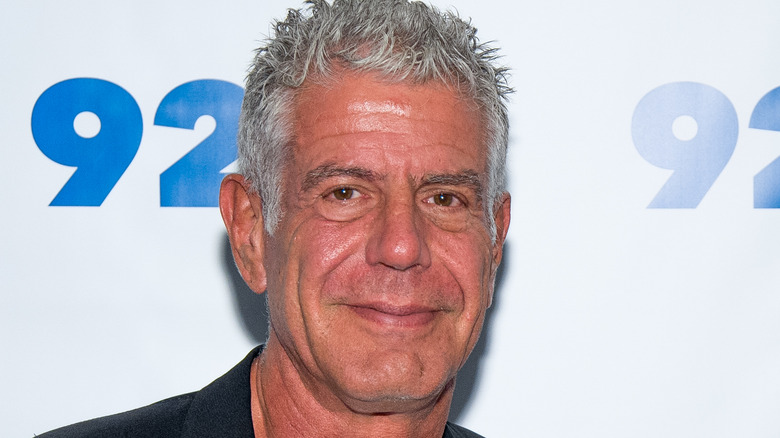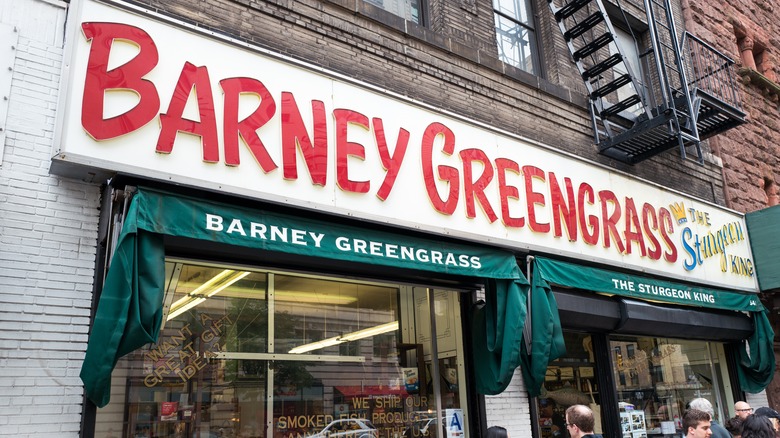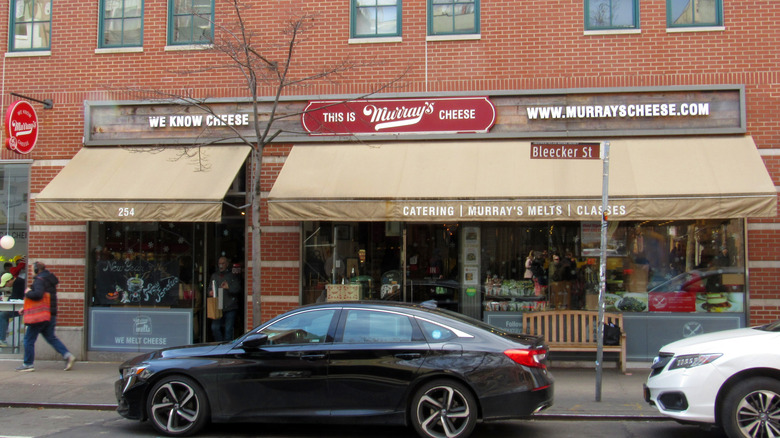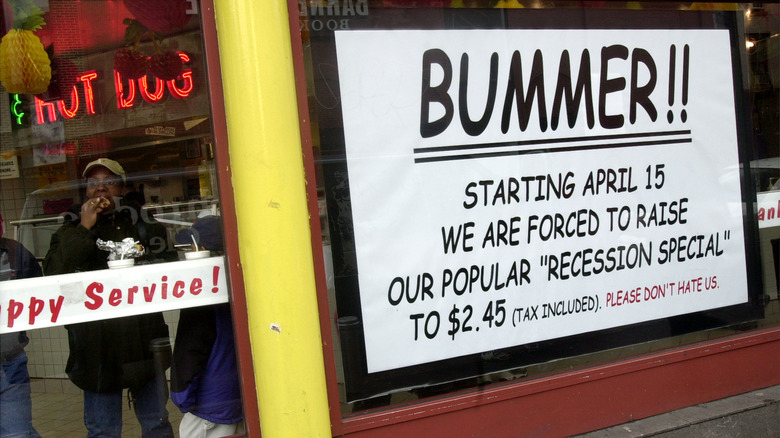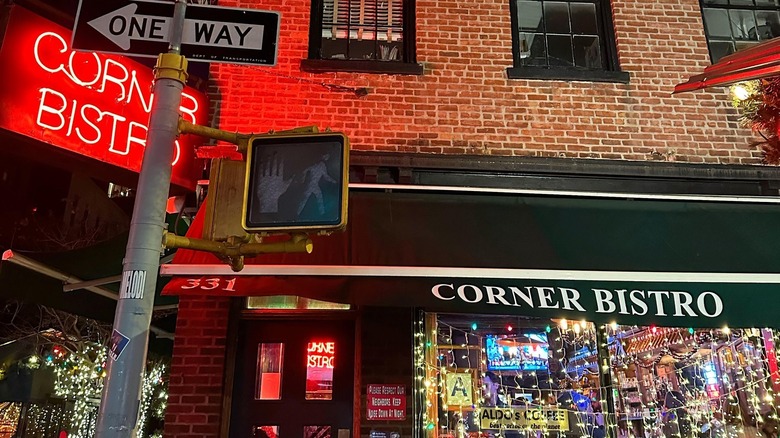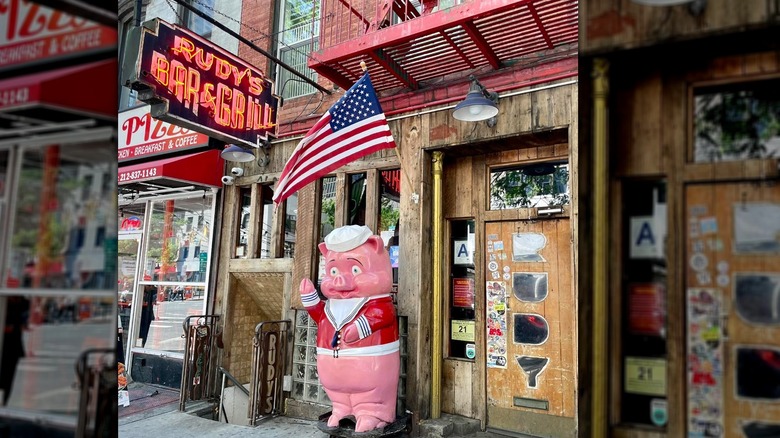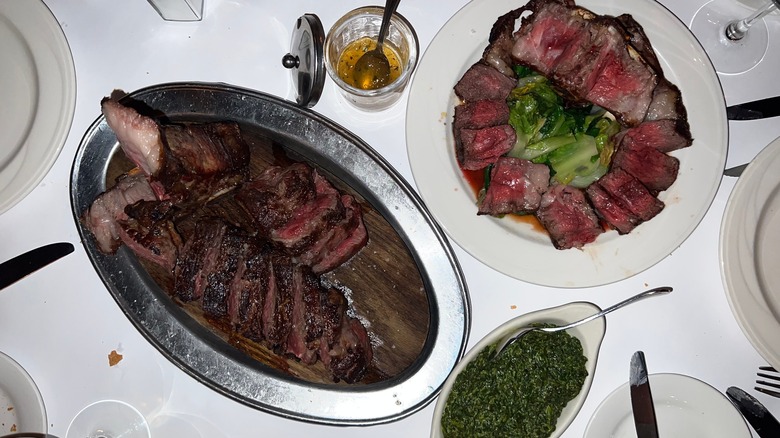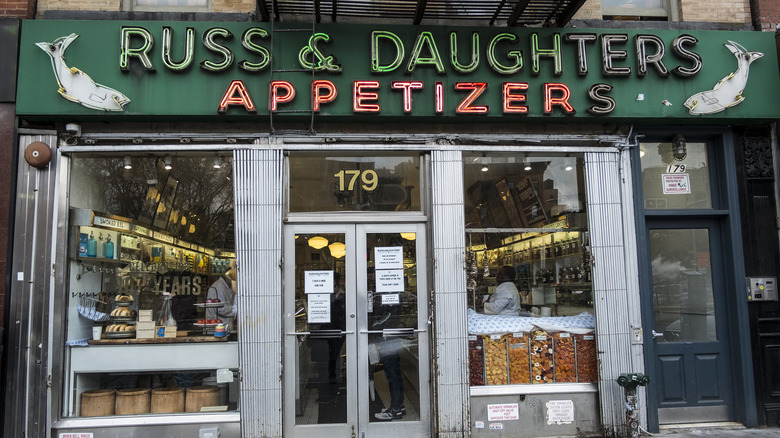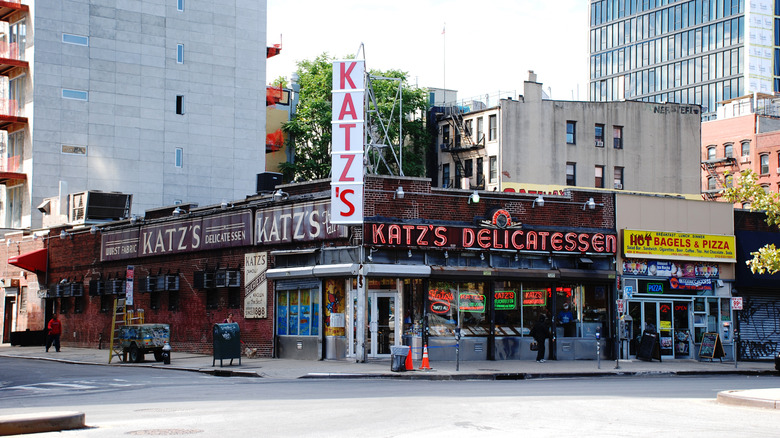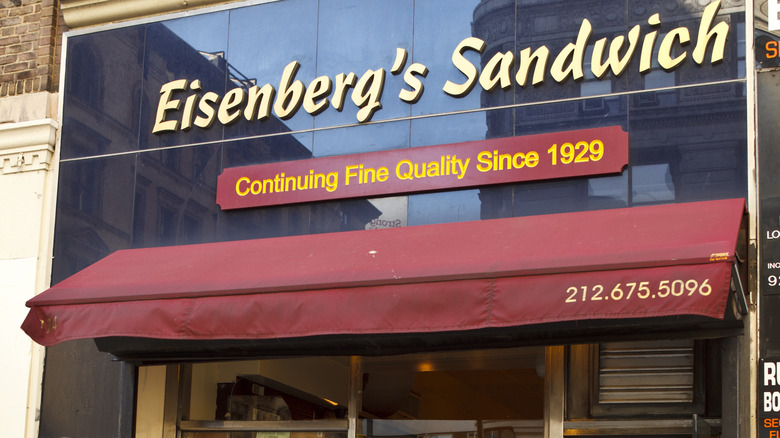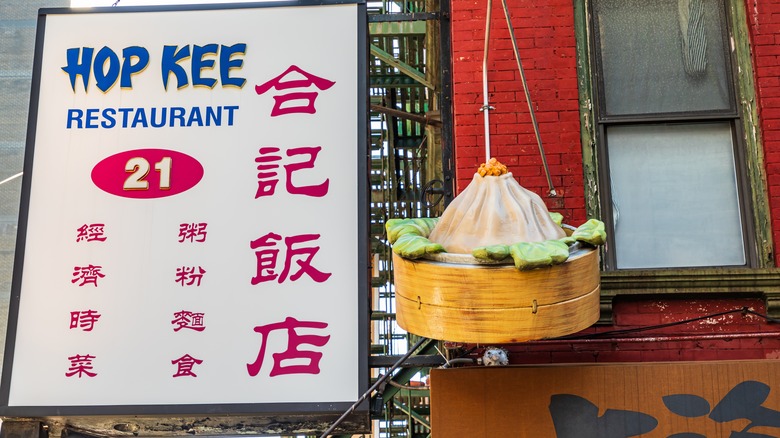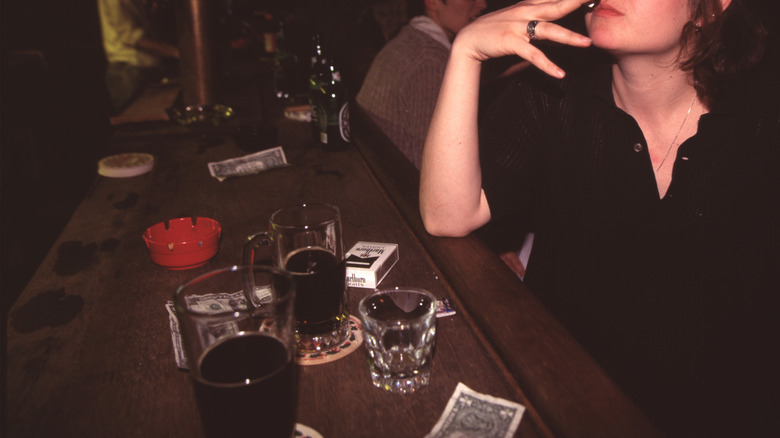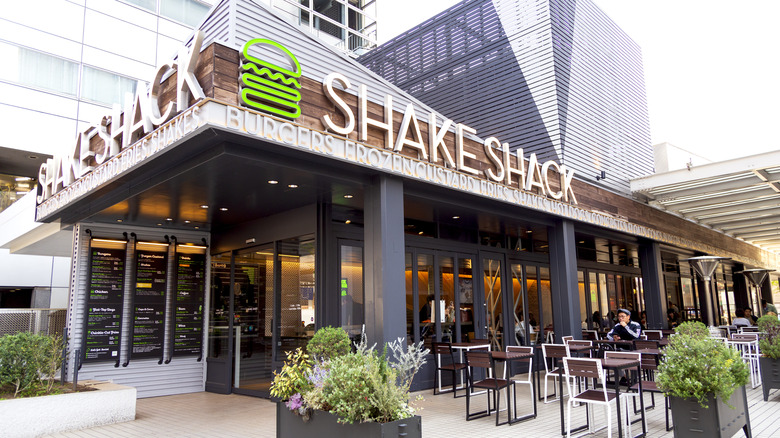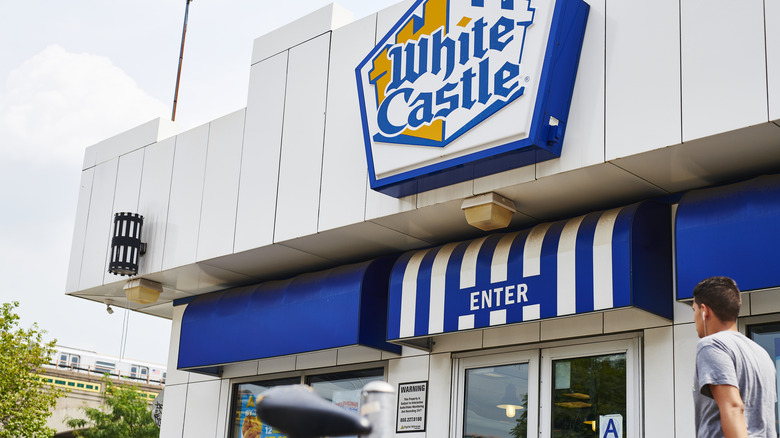Anthony Bourdain's 18 Favorite Spots To Eat And Drink In New York City
The late, great Anthony Bourdain loved New York City. Well, okay, maybe it would be more accurate to say he loved to hate New York City. Whenever he spoke about it, he would reminisce about what the city used to be and grumpily kvetch about what it had become. Born in Manhattan in 1956, he took a few detours along the way, but the story of Bourdain's life was still centered on the metropolis.
From early restaurant gigs to the executive chef job at Brasserie Les Halles that made him notorious, his first big wave of media attention for his New Yorker essay "Don't Eat Before Reading This," to the last episode of his hugely successful series "Parts Unknown" filmed in the Lower East Side, Bourdain remained an advocate for the old New York of times long gone.
The restaurants that made it to this list were selected because these were places that Tony himself scouted and had been to multiple times before recommending. In an early episode of his series "A Cook's Tour," Bourdain says, "The best places in New York are those that never stray from what they're good at. That's what keeps bringing me back." We compiled those places that kept bringing him back, assembled for your own nostalgic restaurant tour.
Barney Greengrass
Barney Greengrass was one of Anthony Bourdain's first televised New York restaurant recommendations. In "A Cook's Tour," Season 1, Episode 19, Bourdain pays a visit to this Jewish deli, which is located in what used to be his own neighborhood. Barney Greengrass opened in 1908 and has been serving up appetizing classics ever since. To this day, it remains one of those places untouched by time, where you can order all variety of smoked fish, assemble it yourself on a bagel, and call it breakfast.
Bourdain starts his review by stating emphatically, "Essential ingredients for a balanced breakfast: New York Times, Barney Greengrass, cigarettes." He then orders a sturgeon platter, with a side of nova eggs and caramelized onions. "Sturgeon is much lighter than smoked salmon," he explains, claiming that sturgeon is the king of smoked fish. The sturgeon platter comes with big hunks of the flaky fish; he cuts himself a slice, eats it on a plain bagel with a schmear, smacks his lips with satisfaction, and remarks, "If God made anything better, he kept it for himself."
Murray's Cheese
Murray's Cheese also made it to Season 1, Episode 19 of "A Cook's Tour." This cheese shop makes Bourdain's list because, in his words, "Murray's is the place chefs go for the best cheese in town." He is astounded by the variety of cheese on offer, which he says could only exist in New York, and talks about how much he loves pungent cheese: "The stinkier and runnier, the better."
Murray's Cheese actually ended up defying Bourdain's expectations for its attractiveness — this vast array of cheeses doesn't just exist in New York anymore. There are still three NYC locations of this cheese shop, but now you can get Murray's cheese just about anywhere in the U.S.; it's sold in Kroger, Mariano's Supermarket, Pick 'n Save, and Metro Market.
Papaya King
Another of Anthony Bourdain's hometown favorites that got a shoutout in "A Cook's Tour," Season 1, Episode 19,is the Upper East Side location of Papaya King. Tony unveils his pick by saying, "Let's face it: The Upper East Side sucks. I come here about as often as I come to Cambodia, which is never. There is, however, one shining light, one temple of cuisine."
This Papaya King is considered a temple by Bourdain because it serves his absolute favorite food combo. "It's a classic," he explains. "It's like red wine and beef, white wine and fish ... papaya drink with a hot dog." He orders one dog with sauerkraut, another with onions, and a papaya drink, and the delight on his face is palpable. These days, the famous Papaya King is still just as proud of its "tropical deliciousness and snappy frankfurters."
Corner Bistro
"You know, there's something to be said about the lonely bar," Bourdain says on Season 2, Episode 5 of "A Cook's Tour." "No obtrusive shouting or groping. It's a place where you can sit quietly, unwind, reflect on your day or your troubles."
Another element that appeals to Bourdain is a good jukebox, which is what brought him to Corner Bistro in the West Village. He also goes because of the good bar food. Specifically, at Corner Bistro, the good bar food is the burger. Bourdain says that hamburgers are the "ultimate bar food" — and the best bar to get them at is Corner Bistro. He says, "The big cheese of bar burgers is at the corner bistro in New York City: robust, honest, greasy, and good — good."
Rudy's Bar and Grill
Hell's Kitchen dive bar Rudy's Bar and Grill also makes it to Bourdain's list of great bars on Season 2, Episode 5 of "A Cook's Tour." He lauds the jukebox as one of the best in New York City, "and ergo, the world." But he's actually there for the special: "This is Rudy's, home of the free weenie."
Embarrassed to have come primarily for a free hot dog, Bourdain pretends to order it as an afterthought. In the episode, he keeps his order simple, just requesting mustard on top. Although it's been about a decade since Bourdain's visit, Rudy's still offers those free hot dogs.Rudy's has been handing out cheap beer and free hot dogs with any purchase since 1933, and it shows no signs of stopping.
Gray's Papaya
A few years later, in his "No Reservations" era, Bourdain switches from being nostalgic to pissed off at the concept of losing New York to a wave of tourists with no taste. In Season 3, Episode 8, he claims that 42nd Street is unrecognizable to him and exclaims as he walks around: "Where is the sleaze?"
In this episode, Bourdain takes out his frustrations on a shooting range with his cab driver Fat Dave and then goes to hot dog and papaya shack Gray's Papaya for a late-night snack. "Nothing like the smell of cordite to make you hungry," he says. "This is where I drop by after a couple of drinks or a couple of rounds of ammo for a cost-efficient, nutritious snack."
"It's all about the papaya drink. It's the perfect accompaniment to a glistening wiener," he tells Fat Dave. They both order the recession special, two hot dogs and a medium tropical drink, which you can still order today. Sure, it's more expensive than it was back then, but it's still pretty cheap.
Keens Steakhouse
Later in Bourdain's "No Reservations" series, in Season 5, Episode 8, the chef and host does a whole feature called "Disappearing Manhattan," focusing on the long-running institutions that make this city great. He says,"What most sentimental fools and urban historians would call the 'golden age of Manhattan' was long gone when I came along." In this episode, he recalls his time as a 15-year-old bicycle messenger when Manhattan seemed to be on a "long, slow, irreversible decline."
The antidote? Keens Steakhouse is an old-school steakhouse that's been open since 1885. Bourdain approves: "You really can't do any better or more authentic than Keens, a place that goes right back to the old-school, all-male world of beefsteak parties, a political power built around beef, and bloody aprons and smoke-filled rooms."
He visits with guest Josh Ozersky (aka Mr. Cutlets), an author and food writer. They order a jumbo shrimp cocktail, a king's cut prime rib, mutton chops, and cream spinach, as they debate the essential components of an old New York steakhouse; they agree on wooden walls and unappetizing veggie sides.
Russ & Daughters
Bourdain's "Disappearing Manhattan" episode heads to Russ & Daughters.Bourdain and his special guest, author Joel Rose, chat with Mark Russ, whose grandfather opened Russ & Daughters in 1907. It started out as a pushcart where you'd get your herring to-go wrapped in the newspaper of the day, and became one of the longest-lasting appetizing stores in New York iconic for its slow, deliberate service and its cured fish. These days, Russ & Daughters is still going strong; the business has expanded to three locations, with a fourth on its way.
Bourdain and Rose get the classic treatment during their visit. They taste a cut of the fish they're ordering on paper first to make sure it's good. Bourdain then orders herring in cream sauce and a bagel with cream cheese and lox. In this episode, he is filled with praise, saying, "Bagel, cream cheese, and lox. Is there any more classic combination? Is there anything more New York?"
Katz's Delicatessen
Bourdain recommends Katz's Delicatessen in "Disappearing Manhattan." Opened in 1888, this Jewish deli is famous for its meats — ruben, corn beef, and, of course, pastrami. Bourdain calls Katz's a "celebrity all its own" and "that most quintessential of New York establishments."
"Maybe because everybody loves Katz's and because everybody remembers Meg Ryan feigning an orgasm here, New Yorkers tend to roll their eyes a little when outsiders gush about the place," Bourdain says. "But, you only need to walk over to the counter, take a long lingering look at that heap of steaming pastrami, corn beef, and brisket, take a deep breath, and you remember again what it means to be alive, to be proud, to be a New Yorker."
His favorite order is pastrami on rye, which promptly falls apart in his hands. "See, there's always in a really good pastrami sandwich, there is this structural integrity problem, which is a good thing," Bourdain says, smiling.
Eisenberg's Sandwich
The "Disappearing Manhattan" special in Season 5 features a lunch counter across from the Flatiron building called Eisenberg's Sandwich Shop. This spot opened in 1929 and, because it was a prohibition-era establishment, it exclusively serves non-alcoholic beverages.
Cabby Fat Dave is back by Bourdain's side for the visit. They split an egg cream and a lime rickey, an old-fashioned mocktail recipe based on a gin rickey (without the gin, of course). Bourdain says, "The lime rickey, I don't even know what the hell they are, all I know is that I love them. Maybe, what, lime juice, cherry syrup, and seltzer? Considering the alarming color, it's a truly delicious thing."
Next up, Bourdain orders a sandwich. "Sublime tuna salad on white and prices are pretty much along 1985 lines," he says. These days, we wouldn't go so far as to say that the prices are entirely stuck in time, but you're still definitely going to get a deal at Eisenberg's.
Hop Kee
The Hop Kee "Disappearing Manhattan" stop is purely nostalgic. "I think maybe we lost something," Bourdain reminisces in this episode about old-school Cantonese restaurants, the type where you can order those classic Chinese American dishes: fried rice, egg rolls, etc. He visits one such restaurant called Hop Kee with chef Chris Cheung.
Bourdain gushes about the menu, "They still got the good old stuff at this place, the gluey faux-Cantonese I can't help but be sentimental about." He orders wonton soup, egg roll, BBQ spare ribs, pork fried rice, and sweet and pungent pork, adding, "I happen to like MSG, by the way." Then Cheung reveals the secrets of what he called the "phantom menu." He orders dishes that he ate growing up, that he knows the kitchen can prepare. Bourdain tries a few bites and concludes, "So my whole childhood was a hollow sham."
Sophie's
Bourdain's "Disappearing Manhattan" episode from the "No Reservations" series ends at dive bar Sophie's, located in the East Village. He visits with writer Nick Tosches, whom he calls "the truly legendary, notorious figure in the history of everything that was ever cool." What's the draw for them both, according to Bourdain? "Sophie's, in the East Village, remains a good place to stop time."
"Is there any place left in New York where an old guy can have a drink in the afternoon and, you know, be a little depressed?" he asks Tosches. They spend their midday drink commiserating about where all the good bars have gone and how even the liquors on the shelves have changed. They also debate which songs need to be available on the jukebox in a perfect dive bar: They both agree on Sinatra.
Shake Shack
The first Shake Shack was just a hot dog stand in Madison Square Park. After opening in 2001, it attracted the attention of many tastemakers like Bourdain and experienced truly rapid expansion. Now, the chain has gone fully international, with locations in countries all over the world.
In a 2016 interview with the Daily Beast, Bourdain proudly proclaims his love for this particular fast-food burger: "Chances are, the first thing I'm doing when I get back if I've been away for 12 days ... I'm calling Seamless to get me some Shake Shack." Bourdain explains that his normal order is a double cheeseburger served "naked," without lettuce or tomato. " He says, "I'll have two of those and I'm happy. I'm singing America, f*** yeah!"
This isn't the first time he lauded restauranteur Danny Meyer's chain. In 2011, he told The New York Times, "When a Shake Shack opened a block from my house, I dropped to my knees and wept with gratitude."
White Castle
A man of truly democratic tastes, Bourdain didn't draw the line at Shake Shack. "Is it the best hamburger in the world? Far from it, my friends," Bourdain said, before biting into a White Castle burger on Season 4, Episode 2 of "Parts Unknown." Bourdain had a deep respect for things that had been around a while without changing, and no place better fits that mold than White Castle. In fact, in some ways, White Castle paved the way for fast food burgers; the square, smaller burgers White Castle served that we've come to know as sliders allowed for an expedited cooking time. The cutesy packaging made it easy to take them away, thereby setting the tone for other fast-food burger joints.
Regardless of the history of the institution, Bourdain's connection with White Castle was wholly personal. He explained in the episode, "If you grew up with White Castle, like I did, ... this connects with some deep, dinosaur part of the brain, evoking a powerful emotional response."
Ray's Candy Store
Bourdain's death by suicide was discovered in 2018. At the time of his death, he had been partway through filming Season 12 of his show "Parts Unknown;" in memoriam, the remaining episodes that were fully filmed were released post-mortem, lacking Bourdain's classic narration. The final episode of the season focused on the Lower East Side, making it a fitting last word on Bourdain's favorite places to eat in the city he grew up in.
By this point in the show's arc, Bourdain spends much less time talking about food and more time talking about people and history. He visits Ray's Candy Store with drummer Harley Flanagan. In the few moments they spend at Ray's, Bourdain orders a chocolate egg cream. Flanagan thanks Ray for the egg cream. Bourdain says, "That is a superb egg cream."
According to the New York Post, Ray's fell on hard times during the pandemic, and the business was saved by a community fundraising effort that raised over $50,000.
Veselka
Bourdain's "Parts Unknown" tour of the Lower East Side includes Veselka, a Ukrainian restaurant famous for its traditional Ukrainian fare, including borscht and many flavors of pierogi potato-based dumplings. Sadly for us (and for Veselka), we don't get commentary from Bourdain here about the food at all — the biggest shoutout in the Veselka clip is some B roll of pierogis being formed with a Boomerang-like effect applied.
Bourdain is there to eat with Danny Fields, author and journalist. Bourdain's love for music, and punk in particular, is written all over this episode, and his reverence for Fields is the most important thing about this visit: "Without Danny Fields, there would be no punk rock," he says. He tells Fields that he needs to write a memoir and that, if he did, it would be 800 pages.
Luckily, Veselka didn't really need the publicity then and still doesn't now. Ever since Russia invaded Ukraine in early 2022, Veselka and its surrounding Ukrainian neighborhood have received an influx of support. Lines that were already long have gotten even longer.
Emilio's Ballato
Bourdain's "Lower East Side" episode contains a few good, old-fashioned Italian joints. The first of these is Emilio's Ballato, a Southern Italian restaurant that first opened in 1956 under the care of John Ballato. Since then, the restaurant has changed hands; now, it's operated by Emilio Vitolo, who hails from Napoli. Despite being owned exclusively by Southern Italians, this place is famous for its Bolognese — go figure.
In this episode, Bourdain gets caught up in music history again. He visits Emilio's Ballato with Debbie Harry and Chris Stein, members of the band Blondie. Bourdain compliments their kindness and willingness to take other lesser-known artists like Fab 5 Freddy along with them on the rise to the top. "You introduced the notion that street art was really art," Bourdain says. Harry claims her band's part in heralding in the genre of rap: She says that they created the first song with a short rap verse included in it and "made it viably commercial."
John's of 12th St
One Italian restaurant featured in the Lower East Side episode of "Parts Unknown" is John's of 12th Street, an Italian spot serving only the most classic Italian American dishes. That's right, we're talking about pasta with meat sauce, eggplant alla parmigiana, chicken scallopini — the works. This place has recently expanded its repertoire to include a whole vegan section of the menu, so it's accessible to most eaters.
Bourdain visits John's with artist and personal friend Joe Coleman, and they talk about the '80s in New York: Coleman's art and his angry performances, their time using hard drugs, the cultural shift of the AIDS epidemic, and the friends that went missing along the way. As he gets into the difficult stuff, Bourdain eats pesto with spaghetti, a simple dish.
